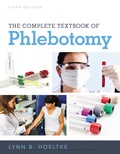
The Complete Textbook of Phlebotomy
5th Edition
ISBN: 9781337514767
Author: Hoeltke, Lynn B.
Publisher: Cengage Learning
expand_more
expand_more
format_list_bulleted
Concept explainers
Question
error_outline
This textbook solution is under construction.
Knowledge Booster
Learn more about
Need a deep-dive on the concept behind this application? Look no further. Learn more about this topic, health-nutrition and related others by exploring similar questions and additional content below.Similar questions
- In the context of cell biology, what do we mean by form follows function? What are a least two examples of this concept?arrow_forwardFigure 4.7 Prokaryotic cells are much smaller than eukaryotic cells. What advantages might small cell size confer on a cell? What advantages might large cell size have?arrow_forwardThe eukaryotic cell in the photo on the left is in the process of cytoplasmic division. Is this cell from a plant or an animal? How do you know?arrow_forward
- Which of the following statements is correct? a. Ribosomes are only found in bacteria and archaea. b. Some animal cells are prokaryotic c. Only eukaryotic cells have mitochondria d. The plasma membrane is the outermost boundary of all cells. e. Some cell membranes do not consists of lipids.arrow_forwardMatch each organelle with its correct function.arrow_forwardAssign a function(s) to the following cellular structures: a. plasma membrane b. mitochondrion c. nucleus d. ribosomearrow_forward
- Organelles and Cystic Fibrosis A plasma membrane transport protein called CFTR moves chloride ions out of cells lining cavities and ducts of the lungs, liver, pancreas, intestines, and reproductive system. Water that follows the ions creates a thin film that allows mucus to slide easily through these structures. People with cystic fibrosis (CF) have too few copies of the CFTR protein in the plasma membranes of their cells. Not enough chloride ions leave the cells, and so not enough water leaves them either. The result is thick, dry mucus that clogs the airways to the lungs and other passages. Symptoms include difficulty breathing and chronic lung infections. In 2000, researchers tracked the cellular location of the CFTR protein as it was being produced in cells from people with CF (Figure 3.13). Figure 3.13 Cellular location of the CFTR protein. Graph compares the amounts of CFTR protein found in endoplasmic reticulum, vesicles travel in g from ER to Golgi, and Golgi bodies in CF cells and normal cells. Which organelle contains the least amount of CFTR protein in normal cells? In CF cells?arrow_forwardOrganelles and Cystic Fibrosis A plasma membrane transport protein called CFTR moves chloride ions out of cells lining cavities and ducts of the lungs, liver, pancreas, intestines, and reproductive system. Water that follows the ions creates a thin film that allows mucus to slide easily through these structures. People with cystic fibrosis (CF) have too few copies of the CFTR protein in the plasma membranes of their cells. Not enough chloride ions leave the cells, and so not enough water leaves them either. The result is thick, dry mucus that clogs the airways to the lungs and other passages. Symptoms include difficulty breathing and chronic lung infections. In 2000, researchers tracked the cellular location of the CFTR protein as it was being produced in cells from people with CF (Figure 3.13). Figure 3.13 Cellular location of the CFTR protein. Graph compares the amounts of CFTR protein found in endoplasmic reticulum, vesicles traveling from ER to Golgi, and Golgi bodies in CF cells and normal cells. In which organelle is the amount of CFTR protein most similar in both types of cells?arrow_forwardThe main function of the endomembrane system is _______ . a. building and modifying proteins and lipids b. isolating DNA from toxic substances c. secreting extracellular matrix onto the cell surface d. producing ATP by aerobic respirationarrow_forward
- What controls the passage of molecules into and out of the nucleus? a. endoplasmic reticulum, an extension of the nucleus b. nuclear pores, which consists of membrane proteins c. nucleoli, in which ribosome subunits are made d. dynamically assembled microtubules e. tight junctionsarrow_forwardEnzymes contained in __________ break down worn-out organelles, bacteria, and other particles. a. lysosomes b. mitochondria c. endoplasmic reticulum d. peroxisomesarrow_forwardWhy is cell furrowing important in cell division? If cytokinesis did not occur, what would be the end result?arrow_forward
arrow_back_ios
SEE MORE QUESTIONS
arrow_forward_ios
Recommended textbooks for you
 Concepts of BiologyBiologyISBN:9781938168116Author:Samantha Fowler, Rebecca Roush, James WisePublisher:OpenStax College
Concepts of BiologyBiologyISBN:9781938168116Author:Samantha Fowler, Rebecca Roush, James WisePublisher:OpenStax College Biology 2eBiologyISBN:9781947172517Author:Matthew Douglas, Jung Choi, Mary Ann ClarkPublisher:OpenStax
Biology 2eBiologyISBN:9781947172517Author:Matthew Douglas, Jung Choi, Mary Ann ClarkPublisher:OpenStax
 Human Physiology: From Cells to Systems (MindTap ...BiologyISBN:9781285866932Author:Lauralee SherwoodPublisher:Cengage Learning
Human Physiology: From Cells to Systems (MindTap ...BiologyISBN:9781285866932Author:Lauralee SherwoodPublisher:Cengage Learning Biology Today and Tomorrow without Physiology (Mi...BiologyISBN:9781305117396Author:Cecie Starr, Christine Evers, Lisa StarrPublisher:Cengage Learning
Biology Today and Tomorrow without Physiology (Mi...BiologyISBN:9781305117396Author:Cecie Starr, Christine Evers, Lisa StarrPublisher:Cengage Learning


Concepts of Biology
Biology
ISBN:9781938168116
Author:Samantha Fowler, Rebecca Roush, James Wise
Publisher:OpenStax College

Biology 2e
Biology
ISBN:9781947172517
Author:Matthew Douglas, Jung Choi, Mary Ann Clark
Publisher:OpenStax


Human Physiology: From Cells to Systems (MindTap ...
Biology
ISBN:9781285866932
Author:Lauralee Sherwood
Publisher:Cengage Learning

Biology Today and Tomorrow without Physiology (Mi...
Biology
ISBN:9781305117396
Author:Cecie Starr, Christine Evers, Lisa Starr
Publisher:Cengage Learning
Biology - Intro to Cell Structure - Quick Review!; Author: The Organic Chemistry Tutor;https://www.youtube.com/watch?v=vwAJ8ByQH2U;License: Standard youtube license